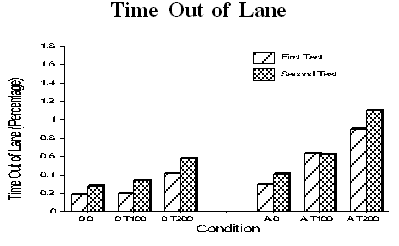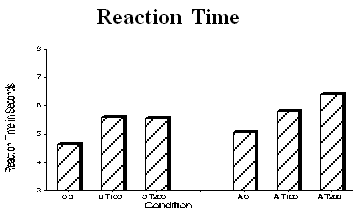 |
Traffic Tech |
||
|---|---|---|---|
 | Technology Transfer Series | ||
| Number 201 | June 1999 | ||
MARIJUANA & ALCOHOL COMBINED INCREASE IMPAIRMENT
[Erowid Note: One problem with this report is that it has an HTML / OCR error which seems to have lost the 'micro' character from in front of the grams, so the version we received included absurd doses. We changed the document to include "ug" (microgram) wherever there was just "g" for the concentration of THC in blood.]
Original URL: http://www.nhtsa.dot.gov/people/outreach/traftech/pub/tt201.html
While alcohol is clearly the predominant drug in fatal crashes, marijuana is the next drug most frequently found in crash-involved drivers. Alcohol and marijuana are often found together (See Traffic Techs 57 and 62, 1993 and 1994).
The Institute for Human Psychopharmacology at Maastricht University in the Netherlands has completed the second of a series of studies for the National Highway Traffic Safety Administration (NHTSA) to assess the separate and combined effects of marijuana and alcohol on driving performance in real driving situations. Eighteen subjects between the ages of 20 and 28 who said they smoked marijuana and drank alcohol at least once a month participated in the study. They were all licensed drivers; half were males and half were females.
Each participant was dosed with marijuana alone, alcohol alone, a combination of marijuana and alcohol, or neither. There were two levels of 9-tetrahydrocannabinol (THC), the primary psychoactive ingredient of marijuana, tested: a low dose at THC 100 ug/kg body weight and a moderate dose at THC 200 ug/kg. A third, marijuana placebo, containing marijuana leaf from which the THC had been removed, was also run. These levels were selected based on an earlier NHTSA study. There were two levels of alcohol tested: an initial alcohol dose sufficient to achieve a blood alcohol concentration (BAC) of about 0.07 ug/dl and an alcohol-free placebo. Since alcohol concentration declines with time, booster doses of alcohol were given later in the test to sustain BACs around 0.04 ug/dl during testing, well below the per se levels in the United States.
There were two on-road test scenarios. The Road Tracking Test measured a driver's capability to maintain a constant speed of 62 mph (100 km/h) and a steady lateral position between the boundaries of the right traffic lane. The Car Following Test measured drivers' reaction times and headway variability (distance between vehicles) while driving 164 feet (50 m) behind a vehicle that executed a series of alternating accelerations and decelerations. On a given test evening after dark, participants smoked the marijuana or placebo, and drank the alcohol or placebo, and then waited 30 minutes to begin the driving tests. On a particular evening, they drove each of the two 25 mile long tests on real roads with real traffic twice (first and second repetitions), accompanied by a driving instructor with separate dual controls.
Deviations in Lateral Position

| 0 0 = no alcohol, no THC | A 0 = alcohol, no THC |
| 0 T100 = no alcohol, THC 100 g/kg | A T100 = alcohol, THC 100 ug/kg |
| 0 T200 = no alcohol, THC 200 ug/kg | A T200 = alcohol, THC 200 ug/kg |
Lateral Position and Time Out of Lane
The graph above shows the average or mean deviation of lateral position during the Road Tracking Test. In practical terms, it's a measure of the composite index of allowed weaving, swerving, and overcorrecting. Failures to keep the vehicle within the boundaries of the lane are shown in the next graph, Time Out of Lane.
Both THC doses alone, and alcohol alone, significantly impaired performances on both road tests, compared with the baseline (no alcohol, no marijuana). Performance deficits were minor after alcohol and the low THC dose, and moderate after THC 200 ug/kg. Combining marijuana with alcohol, however, severely impaired performance, leading to decrements in performance as great as for driving with BACs at .09 and .14, respectively. These comparisons are based on previous research documenting alcohol-induced performance deficits. The percentage of the time a driver spent out of lane increased with the severity of drug effects, until arriving at 1.1 percent after the combination of alcohol and THC 200 ug/kg.

Reaction Time
The next graph shows how reaction times increased with each drug or alcohol dose, compared with the baseline (00). With neither THC nor alcohol, the mean reaction time was 4.65 seconds. This is the time it took for an unimpaired driver to begin to initiate a response. Reaction time increased to 6.33 seconds under the combined influence of alcohol and THC 200 ug/kg, a 36 percent performance decrement.
Considering that their vehicles were traveling at 59 mph at the time, this delay meant that the vehicle traveled, on average, an additional 139 feet beyond the point where the subjects began to decelerate. Even the lower THC dose, by itself, retarded the subjects' mean reaction time by 0.9 seconds.
Another measure was the average headway, or distance between the lead and following vehicles.

In every drug condition, there was a diminished ability to perceive and/or respond to changes in the relative velocities of other vehicles, and to adjust one's own vehicles' speed accordingly.
Conclusions
Marijuana, even in low to moderate doses, negatively affects driving performance in real situations. While previous research on alcohol effects alone show that alcohol at BACs around .10 is far more impairing than low or moderate THC doses alone, marijuana does impair driving performance. Drivers would be less than normally able to avoid collisions if confronted with the sudden need for evasive action. The effect of combining moderate doses of alcohol and moderate doses of marijuana resulted in a dramatic performance decrement and levels of impairment, as great as observed when at 0.14 BAC alone.
HOW TO ORDER
For a copy of Marijuana, Alcohol and Actual Driving Performance (39 pages), prepared by the Institute for Human Psychopharmacology, write to the Media and Marketing Division, NHTSA, NTS-21, 400 Seventh Street, S.W., Washington, DC 20590, or send a fax to (202) 493-2062.
U.S. Department
of Transportation
National Highway
Traffic Safety
Administration
400 Seventh Street, S.W. NTS-31
Washington, DC 20590
Traffic Tech is a publication to disseminate
information about traffic safety programs,
including evaluations, innovative programs,
and new publications. Feel free to copy it as you wish.
If you would like to receive a copy contact:
Linda Cosgrove, Ph.D., Editor, Evaluation Staff
Traffic Safety Programs
(202) 366-2759, fax (202) 366-7096
E-MAIL: lcosgrove@nhtsa.dot.gov


